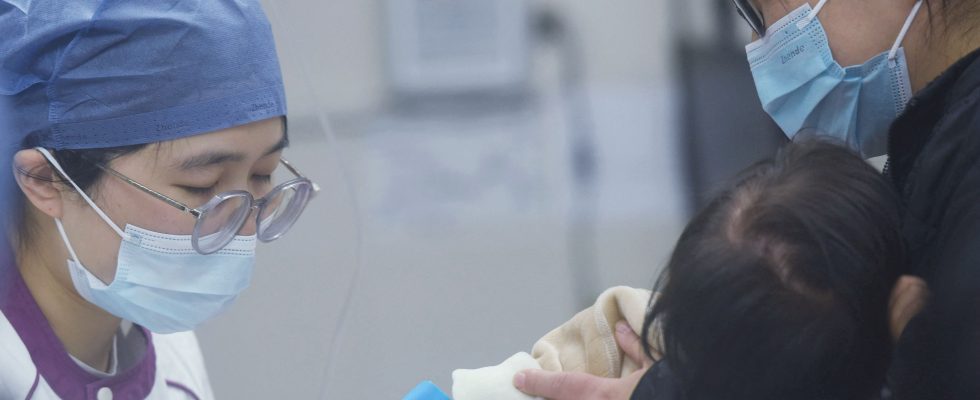Do not panic ! This is the mantra of the Chinese authorities after the announcement of an increase in respiratory illnesses, mainly among children, in recent weeks in the north of the country. Nearly four years after the appearance in China of a mysterious “viral pneumonia” now known as Covid-19, the alert has revived fears of a potential new pandemic. Especially since the images broadcast on social networks and published in state media recall the dark hours of the end of 2019 in Wuhan. For example, we can see crowded waiting rooms with beds lining the corridors of a hospital in Hebei, patients and their relatives wearing surgical masks. Monday, November 20, the international monitoring system ProMED – at the origin of the first signal at the end of 2019 on the mysterious pneumonia which will turn out to be Covid-19 – alerted on hospitals “overwhelmed with sick children” with a respiratory infection unknown. A few cases of adults, notably teachers, have been mentioned. An outbreak reported mainly in Beijing and cities such as Liaoning (northeast).
Since then, the situation does not seem to improve. According to the official newspaper Global Times Tuesday, November 28, the Beijing Children’s Hospital received up to 9,378 patients… per day! And has been operating at full capacity for two months. The media also claims that the number of infusions is 49% higher than usual in this establishment, when the number of beds for patients with pneumonia has increased by 40.5%. The symptoms reported? Fever, lung inflammation without cough, sometimes lung nodules – lumps on the lung resulting from an infection, detected by X-ray or CT scan. However, no deaths have been reported. What to worry about though?
Criticized for its delay in responding to Covid, the World Health Organization (WHO) is on guard and wants to show that it leaves nothing to chance. While the first officially reported cases date from November 13, the organization requested more information last week. Result: China responded 24 hours later that “no unusual or new pathogens had been detected.” Good news not to be underestimated. There is “too little information for a definitive assessment”, but what we know “does not suggest an epidemic caused by a new virus, otherwise there would be many more adult infections”, indicates Paul Hunter, from the British University of East Anglia. “The few infections reported in adults suggest (general) immunity arising from previous exposure.”
No “new Covid-19”, therefore, but China is still facing “an increase in outpatient consultations and hospitalizations of children due to mycoplasma pneumoniae since May, and, since October, to RSV, adenoviruses and influenza”, according to a WHO press release. How to explain such a situation? The Chinese authorities evoke a sulfurous cocktail: abandonment of anti-Covid restrictions, arrival of the cold season, circulation of known pathogens (flu virus, bacteria mycoplasma pneumoniae, RSV causing bronchiolitis, SARS-CoV-2), and a lack of immunization in children. “As China experienced a much longer and stricter lockdown than other countries, more substantial waves of ‘exit from lockdown’ were expected there,” Professor François Balloux, of University College of London, told Science UK Media Center (SMC). Catherine Bennett, of Australia’s Deakin University, notes that “young children in school (currently) in China will have spent up to half their lives without the usual exposure to common pathogens, and therefore without the same levels of immunity “.
The mystery of an outbreak of pneumonia
However, if an increase in infections was expected in the country this winter, epidemiologists say they are surprised by the high prevalence of pneumonia in China, certainly caused by mycoplasma pneumoniae. When Covid restrictions were eased in other countries, influenza and RSV were the main drivers of infections. “This is surprising because bacterial infections are often opportunistic and occur after viral infections,” explains Nature Benjamin Cowling, epidemiologist at the University of Hong Kong.
Although pneumonia caused by the bacteria is usually treated with antibiotics, over-reliance on these drugs has led the pathogen to develop some resistance. Studies even show that resistance rates of mycoplasma pneumoniae antibiotics in Beijing are between 70 and 90%. “This antibiotic resistance could contribute to the high levels of hospitalizations due to this bacteria this year, because it can hinder treatment and slow recovery from bacterial pneumonia infections,” continues Benjamin Cowling in the scientific journal. An increase in cases of pneumonia linked to the bacteria which also seems observable in France. From November 13 to 19, Santé Publique France thus noted an increase of 36% SOS Médecins interventions for lung diseases and infections in children under 15 years old.
If winter outbreaks are always a challenge for States, the Chinese health system seems more capable of dealing with them than before the Covid pandemic. Beijing notably has a surveillance system for influenza-like illnesses and severe acute respiratory infections, such as influenza, RSV, SARS-CoV-2. And in mid-October the country began reinforced surveillance of various respiratory diseases, including, for the first time, mycoplasma pneumoniae. Despite everything, some of its neighbors are particularly concerned about China’s lack of transparency during previous epidemics, particularly on the origins of Sars-CoV-2. “Based on available information”, “no specific measures” are recommended for travelers going to China, nor restrictions on travel or trade, specifies the WHO.
